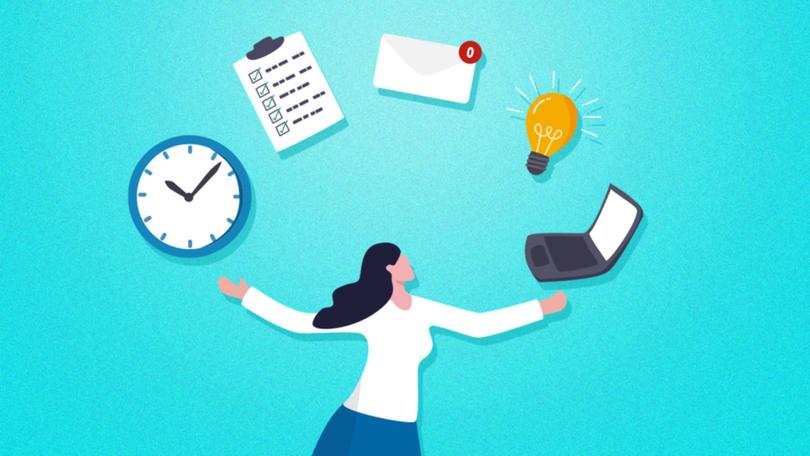JENI O’DOWD: Doing too many things at once often means we’re doing none of them well

I detest the words bitch, dragon lady, ice queen, and ballbreaker, all of which have been used to describe me over the years.
The unfortunate side effect of women reaching leadership positions is how they are expected to behave so differently from their male counterparts. And if they don’t, they are bitches. Or worse.
But I have always been fiercely driven to succeed. And yes, sometimes I was too harsh and rude towards my colleagues. But looking back, I can easily see some (but not all) of the reasons why.
Sign up to The Nightly's newsletters.
Get the first look at the digital newspaper, curated daily stories and breaking headlines delivered to your inbox.
By continuing you agree to our Terms and Privacy Policy.At the height of a long career in the media, my life was a whirlwind of multitasking. I loved being able to juggle numerous tasks simultaneously, even bragging about it to my husband.
I always did several things at once — writing emails, holding meetings, or taking phone calls. Even during chats with colleagues about their latest stories, my attention would drift to my computer screen.
Looking back, it’s clear that this relentless multitasking took its toll. Not only was I pushing myself to the brink, but because I was constantly stressed, I was rude to my colleagues and family.
Multitasking is a story most of us can relate to, from stay-at-home mums to business executives.
One of my friends, who works remotely, still carries the weight of the moment when she pushed multitasking to its limits.
She was doing a phone interview from home, with her six-month-old daughter nearby, occupying herself with a wallet full of coins.
Assuming the coins were secure in the zippered compartment, my friend went ahead with her call. However, mid-interview, she glanced up to find her baby girl choking on a 10-cent coin.
“I remember abruptly ending the call without explanation and rushing to help Ava, who was struggling to breathe. From then on, I made a strict rule to only work during her nap times, regardless of how hectic my day was,” she said.
This frightening incident was a stark reminder of the dangers of attempting to juggle too much.
Professor Peter Wilson, one of Australia’s leading motor performance and development researchers, told The Nightly that we often multitask and can seemingly do this easily when it is something we have had a lot of experience doing.
For instance, walking a footpath (and chatting to a friend at the same time) or driving a car on a familiar route we have taken for years (and tuning the radio). Both take little conscious thought.
But when our primary task becomes demanding, new, or unexpected, it can take a lot of mental energy to complete and may come with a cost.
“Adding another task simultaneously becomes so distracting you simply can’t do one or both properly,” Professor Wilson said.
“In the information age, people are often called on to do more but in the same amount of time, which means they end up working evenings, coming to work earlier, taking calls in the car, or checking emails surreptitiously at the back of the room during meetings.
“They feel pressure to multitask to get everything done and feel on top of their workload and family commitments. And the cost is more stress and trade-offs.”
In the case of driving while taking a phone call, for example, a trade-off (or performance cost) could be a slower reaction time to a car suddenly stopping in front of you or missing a red light, even if the call is hands-free. Also, you’re probably not paying full attention to the call.

Professor Wilson says another cost is emotional. Cortisol levels can rise dramatically when you are under a lot of pressure to juggle many things. In the long term, that can lead to burnout.
An article by the University of Southern California says more and more people in office settings are bouncing back and forth between tasks, believing multitasking leads to increased efficiency.
“New studies, however, have uncovered that multitasking is a cause of concern,” the article says.
“These studies suggest that multitasking causes us to make more mistakes, retain less information, and change how our brain works. This raises questions as to whether multitasking is good for workers.”
Science backs this up. There is an area in your brain — the prefrontal cortex — that begins working anytime you need to pay attention. That area of the brain helps you focus on a single goal and carry out the task at hand by coordinating messages with other brain systems.
Working on a single task means both sides of the prefrontal cortex are working together in harmony.
Professor Wilson says the issue with multitasking at the brain level is that two tasks performed at the same time often compete for common neural pathways, like two intersecting streams of traffic on a road.

In particular, he says, the brain’s planning centres in the frontal cortex (and connections to the parietal-cerebellar system, among others) are needed for both motor and cognitive tasks.
The more tasks rely on the same sensory system, like vision, the greater the interference. So, it’s wise to limit your dual-tasking. Sometimes, it’s necessary, but at other times, it can be costly.
Last year, Australia witnessed a surge in mass redundancies as companies sought to mitigate the impact of rising interest rates and inflation, which continues to hover at high levels.
According to the Australian Bureau of Statistics, about 89,300 workers were made redundant every quarter from November 2022 to August 2023.
With this heavy cost-cutting, the employees who remain are often expected to do more work — but at what cost?
We all have mortgages to pay and feel pressure to keep our jobs and be as productive as possible. We often take on new tasks and heavier workloads without complaint.
And it doesn’t help that society loves a multitasker. There are even terms for great multitaskers — the supermum, the workaholic — which shows the immense pressure we place on individuals, particularly women, to excel in multiple roles.
It may be time for everyone to take a breather.
Jeni O’Dowd is the founder of lifestylenews.com.au
